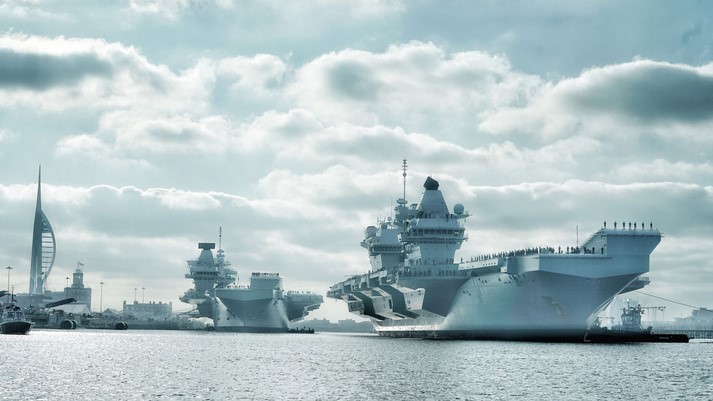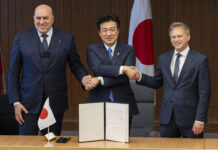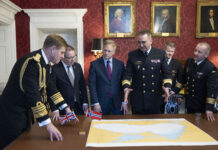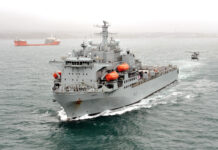In March 2021, the United Kingdom published three closely-linked documents that set out the Johnson administration’s approach to British security and foreign policy in the decade ahead. Seeking to balance the post-Brexit “Global Britain” mantra with current political and economic realities, the new strategy sets out a vision of an energised and engaged nation helping to sustain an “open” international world order through a global military presence whilst building national advantage through innovation in science and technology. High in ambition but low on detail, the strategy risks being derailed by the many contradictions it seeks to reconcile.
Formally launched by Prime Minister Boris Johnson on 26 February 2020, the UK’s Integrated Review of foreign policy, defence, security and international development has been claimed to be Britain’s most fundamental reappraisal of national security strategy since the Cold War’s end. In a statement to the House of Commons, Prime Minister Johnson summarised the review’s objectives as being:
- To define the UK’s role in the world and its strategic aims for national security and foreign policy.
- To examine how the UK would be a burden-sharing and problem-solving nation, working more effectively with allies.
- To determine the capabilities needed to pursue national objectives and address the threats the UK faces.
- To identify the reforms required to government systems and structures to achieve these aims.
- To outline a clear approach to implementation and evaluation of the strategy over the coming decade.
The conclusion of the review was inevitably delayed by the COVID-19 pandemic. However, it says much about the high priority given to the process that – despite the intervening chaos – its results were announced a little over a year after first launch.
The Integrated Review: Process and Publication
During this period, the review’s work was aided by two significant developments. One was the direction provided by publication of a new Integrated Operating Concept by the British Ministry of Defence in September 2020. Attempting to counter rival nations’ exploitation of the ambiguous boundary between peace and war, the concept emphasises maintaining some forces focused on continuous operations to compete with the actions of rivals rather than always making warfighting capabilities the paramount aim. The other was the announcement of a relatively generous budgetary settlement for the British Armed Forces the following November. Promising a £24.1Bn (14 per cent) increase in the defence budget over the following four years. This provided the financial stability that had been notably absent from previous British defence and security reviews.
When eventually published in March 2021, the outcome of the strategic review was essentially split into three elements. First out of the starting gates was the Integrated Review (IR) itself – Global Britain in a competitive age (CP403) – published on 16 March 2021. This was followed by a Defence Command Paper – Defence in a competitive age (CP411) – on 22 March 2021 that explained how the armed forces would be structured to meet the IR’s overarching objectives. A third document – the Defence and Security Industrial Strategy (CP410) – released the following day has received less public attention but forms a fundamental part of the government’s objectives. This sets out how the British defence industrial base will be supported in furtherance of the overall defence and security strategy.
Strategic Conclusions
The principal conclusions of the IR are set out in Global Britain in a Competitive Age. The document commences with Prime Minister Johnson’s vision for the United Kingdom in the 2030s. Inevitably full of political rhetoric and driven by national politics, this viewpoint is dominated by a desire to sell the advantages of a post-EU chapter in British history. This will see the benefits of the union between England, Scotland, Wales and Northern Ireland harnessed to allow a newly-freed UK to become “match-fit for a competitive world.” Much is made of adopting an integrated approach – encompassing security, diplomacy, development and trade – to achieve this outcome. There is also a heavy emphasis on driving national prosperity through leadership in science and technology, not least in tackling climate change and biodiversity loss.
Considerable attention is paid to assessing the environment relating to national security and international relations in the coming decade. Interestingly – despite political withdrawal from Europe in favour of a more global approach – the IR identifies the Euro Atlantic region as remaining critical to British security and prosperity. Moreover, Russia is viewed as remaining the most acute direct threat to the UK. This apparent contradiction is justified by the assertion that global political and economic power will continue to shift eastwards to the Indo-Pacific. In comparison with Russia, the view taken of China – a “systemic competitor” – is more nuanced. This likely reflects the difficult balance between economic and security interests.
Four Objectives
The IR sets four specific strategic national security and international policy objectives for the immediate future. These are:
- Sustaining a strategic advantage through science and technology: this essentially recognises that countries that establish a leading role in critical and emerging technologies will be at the forefront of global leadership.
- Shaping the open international order of the future: this reflects the view that the UK’s openness to the flow of trade, capital, data, ideas and talent is essential to long-term prosperity and that – in a competitive environment – the UK must be more proactive in preventing rivals from determining how the world order that supports these flows functions.
- Strengthening security and defence at home and overseas: this effectively involves strengthening the capabilities of the armed forces to counter state threats to home security whilst allowing a more robust approach on the international stage.
- Building resilience at home and overseas: reflecting the impact of the COVID-19 crisis, this looks at addressing the root causes of risks to the UK in the context of the transnational nature of many challenges and increasing the nation’s readiness to withstand such crises when they occur.
A number of unifying strands run through these objectives. These include the emphasis on trade and technological advancement to secure Britain’s global position. Equally important – and reflecting some of the analysis behind the Integrated Operating Concept – is a focus on international engagement and forward presence to promote British interests on the world stage. This encompasses a strengthening of the United Kingdom’s diplomatic presence and the expansion of a network of global hubs to project Britain’s military influence.
The Impact on the Armed Forces
An important aspect of the IR is the impact its overall conclusions have had on the future force structures and equipment of the British Armed Forces. Although much of this detail had to wait until publication of Defence in a Competitive Age, one highly significant change announced on 16 March related to changes in the posture of the UK’s strategic nuclear deterrent. The 2010 Strategic Defence and Security Review (SDSR) mandated a reduction in British nuclear warheads to no more than 180, of which no more than 120 would be operationally available, by the mid-2020s. This policy has been reversed, with a nuclear stockpile of up to 260 warheads now being planned, Moreover, in an extension of a policy of deliberate ambiguity, public figures for the operational stockpile, deployed warhead or deployed missile numbers will no longer be provided. This policy change has been contentious, particularly since no justification has been provided beyond the evolving security and technological environment. There has been much speculation about the underlying reasoning, with the growing potency of ballistic missile defence systems perhaps one key factor in the decision. The IR makes no changes to the replacement of the existing quartet of Trident-armed VANGUARD class submarines with an equivalent number of DREADNOUGHT type boats from the early 2030s.
Whilst Defence in a Competitive Age provides much information on the future of Britain’s conventional forces, it is notably different from previous defence reviews in not including an explicit force structure – there is much less detail about the numbers attached to specific capabilities and units. This makes it more difficult to assess the trade-offs that have been made in terms of retiring old equipment to pay for new capacity. Taking a cynical view, it also means that it is more difficult to hold the government to account in terms of the successful delivery – or otherwise – of their plans. In general terms, however, the main impact on the various branches of the armed forces can be summarised as follows.
The Royal Navy
If there is a winner as a result of the IR process, this is indisputably the Royal Navy. The review continues to place the continuous availability of a carrier strike group formed around one of the two QUEEN ELIZABETH class vessels at the heart of maritime policy. It supplements this with the creation of two amphibious Littoral Response Groups that will be based in the European and Indo-Pacific theatres and a strategy of forward deployment of light units. An ambitious programme of naval construction confirms all existing programmes whilst heralding, inter alia, an eventual expansion of the frigate force and introduction of a new class of amphibious multi-role support ships. Some short-term pain will be felt by early retirement of two of the ageing Type 23 frigates and the eventual withdrawal of the flotilla of manned Mine Countermeasures Vessels, the latter replaced by unmanned and autonomous systems.
The British Army
Although the IR has resulted in an additional £3Bbn of capital investment in Army capabilities to add to £20Bn already planned, the British Army does less well out of the review process. Its fully trained strength will be cut from a target of 82,000 full-time soldiers to 72,500 (although it should be noted actual strength currently stands at only currently stands at around 76,000), the plan to modernise the WARRIOR IFV is abandoned and the fleet of CHALLENGER MBTs will be reduced. The Army has suffered both from a lack of a clear strategic vision of its future role and a failure to secure the replacement of increasingly obsolescent equipment. The IR aims to provide the resources to achieve the necessary modernisation at the cost of smaller numbers. This will be accompanied by further restructuring to make a more useful force.
The Royal Air Force
The outcome of the review for the Royal Air Force has been more nuanced. A number of aircraft types – including the oldest, Tranche 1 TYPHOON aircraft and HERCULES transporters – will be retired early and plans for an eventual purchase of 138 LIGHTNING II strike fighters look set to be reduced. However, the remaining TYPHOONs will be subject to a programme of spiral development of capabilities in conjunction with development of the new Future Combat Air System that will encompass both the manned TEMPEST aircraft and additional unmanned and autonomous aerial vehicles.
Beyond traditional elements of the armed forces, the IR retains the recent focus on the new domains of cyber and space, where an increasing proportion of the £6.6Bn allocated to research and development over the four years to 2025 is likely to be directed.
The Industrial Context
The refresh of Britain’s defence industrial strategy has been a frequently overlooked part of the IR but is a fundamental part of the overall process. Described as building on the outcomes of the IR and Defence in a competitive age, it replaces the “competition by default” approach that has typified British defence procurement over recent years. Instead, the new plan places greater emphasis on the importance of a sustainable industrial base for both security and economic reasons. Stating that, “We must not only ensure that our forces have the right kit and equipment, but that we maintain capabilities onshore to produce and support critical elements for our national security, and ensure that our supply chains are sustainable and resilient”, the strategy will inevitably lead to a more protectionist stance to future procurement.
In spite of this shift, it is important to note that there is no agenda to close the British defence markets to all competition. Instead, a “flexible and nuanced” stance will be adopted where international competition will be used as appropriate but where other approaches may be preferred where this matches the national interest. The strategy adopts new terminology to guide when competition might not be allowed. “Strategic imperatives” – nuclear deterrence, submarines, cryptography and offensive cyber – are regarded as areas of industrial capacity that are so fundamental to national security that they must be maintained largely onshore. In addition, a wider range of capabilities required for “operational independence” will require the retention of core indigenous capabilities in areas such as systems integration, upgrades and critical components. A more proactive stance will be taken to establish industrial capability priorities. An example of the new approach is provided by a revised naval procurement policy. Whilst not ruling out international competition in appropriate cases, it gives far greater priority to the national shipbuilding base than previously.
The strategy focuses heavily on supporting domestic industry through much closer collaboration in a wide range of areas. This ranges from enhanced information sharing on future requirements through to a renewed drive for exports, including new government-to-government commercial mechanisms. Collaboration with international partners remains important, with the role of multinational companies operating in the UK valued for the investment and employment opportunities that they bring.
Ambiguities and Contradictions
Whilst the IR attempts to provide a holistic and joined up approach to future British security needs, it is notable for some of the contradictions it seeks to reconcile. Prominent amongst these is the need to balance the recognition that the threat to European stability from increased Russian assertiveness is the UK’s paramount security concern against the desire to grow British presence and influence in Asia. This quandary – arguably a direct consequence of Brexit – is at risk of producing an inherently contradictory approach under which limited military potential is being diverted to the Far East when there is an increased need to bolster defences closer to home. The ongoing uncertainty as to whether to treat China as a valued trading partner or a potential enemy only serves to add to this complexity.
Although backed by a meaningful increase in funding, the IR also follows the pattern of previous defence reviews in demanding immediate capability cuts in return for the promise of new, improved equipment in future. Some of the systems being retired – such as TYPHOON fighters and Royal Navy frigates – arguably provide capacity that supports the IR’s security priorities. As always, there also has to be uncertainty over whether the promised new weaponry will be delivered in a timely and effective fashion. The problems afflicting the new AJAX AFV would seemingly put the British Army at particular risk in this regard. The vagueness afflicting the information provided on future force structures that has already been mentioned provides additional ambiguity as to whether there will be a meaningful improvement in overall capacity.
Perhaps most surprising given the strategic imperative of shaping the open international order of the future is the fact that the IR process has coincided with a decision to temporarily reduce spending on international aid and development as a result of the financial strains caused by the COVID-19 pandemic. The amount budgeted for this assistance will fall from the United Nations’ target of 0.7 per cent of Gross National Income (GNI) to 0.5 per cent of GNI for an indeterminate period. For 2021, the cash impact of this reduction has been estimated at over £4Bn. A particularly noteworthy contradiction with stated IR aims is a reported c. £0.5Bn reduction in the cross-departmental Conflict Security & Stability Fund to £0.9Bn during the current year.
Conclusion
The IR represents an ambitious attempt to undertake a comprehensive review of British security requirements in the post-Brexit era. The broad sweep of its purview is arguably both a strength and a weakness. This facilitates a deep understanding of the many and varied factors influencing the national security environment at the expense of producing a complex set of conclusions that might prove difficult to put fully into practice. Many of the IR’s results are welcome. The more stable funding environment; the linkage of security strategy with the Integrated Operating Concept; and the recognition of the strategic importance of the national defence industrial base are all positive developments. However, it is vague on important details and contains a number of important ambiguities. Most fundamentally, its attempt to reconcile the desire to create a “Global Britain” at a time when Europe remains fundamental to British security interests reflects the wider contradictions inherent in Brexit itself.












